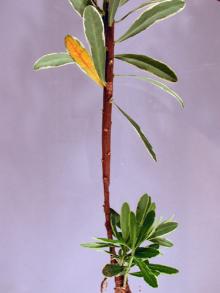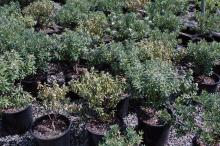Cause Phytophthora sp., a fungus-like microorganism. This organism can survive as a resting structure (chlamydospores and oospores), as hyphae in the roots of diseased plants and in crop debris. It is easily spread in contaminated potting media, disease cuttings or liners and splashing or flowing water. Recycled irrigation water can also be a source. Cool, wet, or waterlogged soil favors disease development. The disease also can occur on sloping ground if soil stays excessively wet.
Although oomycetes (Phytophthora and Pythium) represent most of the root rot samples sent to the OSU Plant Clinic, the following root diseases or fungi have also been found: Armillaria, Black root rot, Fusarium, Rhizoctonia, and Sclerotinia.
Symptoms Above ground, foliage and flowers wilt, or the entire plant collapses. Dark brown to black, irregular, water-soaked lesions appear on the stem near the soil line. These may coalesce into larger lesions that girdle the plant. Invaded cambium turns brownish black and is sharply delineated from adjoining healthy areas. Affected roots disintegrate rapidly.
Cultural control
- Improve water drainage around plantings.
- Reduce irrigation amount and frequency.
- Maintain at a slightly acidic pH and do not over-fertilize with nitrogen.
- Remove and destroy infected plant and potting material including leaves, cuttings, plants, and potting media.
- Collect cuttings for propagation only from healthy stock plants.
- Avoid reusing pots from a previous crop for propagation. If pots must be reused then wash off all debris and soak in a sanitizing solution or treat with aerated steam for 30 min.
Chemical control Focus on cultural controls. If using chemicals, alternate ones from different groups with different modes of action to prevent building up resistant fungal populations. Use fungicides as preventative treatments. The Group 4 and P7 fungicides used to manage Phytophthora do not kill this organism. They can only prevent establishment of the organism before it gets into the plant. They can also prevent continued growth if the organism is already inside the plant thereby delaying symptoms that might have developed. Once chemical activity has subsided with time, the organism can resume growth within infected plants.
- Aliette at 2.5 to 5 lb/100 gal water. Try it on a few plants before using on a large scale. Do not use with adjuvants. Group P7 fungicide. 24-hr reentry.
- Mefenoxam 2 AQ can be used, if not phytotoxic, at 0.98 to 1.96 fl oz/100 gal water as a soil drench. Group 4 fungicide. No restrictions on reentry when used as a soil drench or media incorporation.
- Subdue MAXX. Try it on a few plants before using on a large scale. Group 4 fungicide. 48-hr reentry. No restrictions on reentry when used as a soil drench.
- Terrazole 35 WP at 3.5 to 10 oz/100 gal water. Group 14 fungicide. 12-hr reentry.
- Truban 30 WP at 3 to 10 oz/100 gal water/400 sq ft. Group 14 fungicide. 12-hr reentry.
Reference Tompkins, C.M. and Tucker, C.M. 1951. Stem and root rot of Daphne odora caused by Phytophthora parasitica. Phytopathology 41:654-655.



